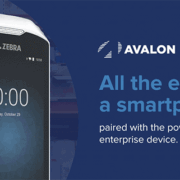Mobile devices have become the foundation of effective modernization since they keep crucial data and connectivity right at your fingertips. They also successfully bridge the gap between teams within a supply chain, automating data capture and sharing through a digital interface. Consequently, handheld devices have become popular across multiple industries, from high-demand manufacturing plants to family-owned storefronts. As customer demands for faster and more accurate fulfillment increased, mobile devices have been enhanced to provide flexible connectivity options, consolidate disparate workflows, and last beyond the standard 8-hour shift.
Despite these enhancements, traditional handheld computers and scanners may still be bulky for workers traveling between different locations. For more on-the-go teams, handheld devices must prioritize automated intelligence alongside ease-of-use and ergonomics.
That’s where touch computers come in.
Today’s cellphones have shaped the expectations for easy-to-use technologies. In as little as zero clicks –thanks to voice commands– users can access files, navigate the web, and send messages. Similarly, Zebra’s touch-computers combine the intuitiveness of consumer-grade touchscreens with the enterprise functionality of traditional rugged handhelds. The result looks a little like this:
Zebra’s latest TC52AX touch-computer is a prime example of user-friendly handheld mobility; however, it is not the only option available. Because different workloads may require different levels of functionality, experts recommend assessing your options with the following three considerations:
- Will scanning capabilities be needed? – While some touch-computers can capture data up to 50ft away, not every workflow requires this. For example, while the TC20/26 may not offer the widest scanning range, it makes up for the difference in long-lasting battery power that surpasses double shifts.
- How far will workers travel? – When it comes to communication outside of the four walls, devices like Zebra’s TC7x offer greater connectivity flexibility, providing secured communication through cellular, 5G, LTE, WiFi, and more.
- Will you be adding additional devices? – From wearable devices like ring scanners and headsets to mobile printers, additional devices will impact worker mobility and comfort. Lightweight devices streamlining multiple workflows benefit workers by minimizing strain and connecting workflows simultaneously.
To help you answer these questions, Avalon recommends scheduling a workflow assessment to select a device that best adapts to your operation. Once a device is selected, automation experts can also assist in procuring and preparing devices for integration through the GO Zebra Trade-In Program for cost-effective and intelligent modernization.


